| |||||
| Decades: | |||||
|---|---|---|---|---|---|
| See also: | Other events of 1613 List of years in Denmark | ||||
Events from the year 1613 in Denmark .
| |||||
| Decades: | |||||
|---|---|---|---|---|---|
| See also: | Other events of 1613 List of years in Denmark | ||||
Events from the year 1613 in Denmark .
Undated
Undated
Undated
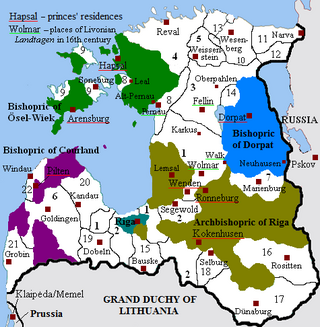
Livonia or in earlier records Livland, is a historical region on the eastern shores of the Baltic Sea. It is named after the Livonians, who lived on the shores of present-day Latvia.
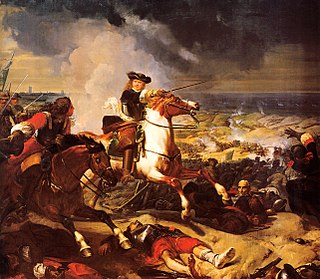
1658 (MDCLVIII) was a common year starting on Tuesday of the Gregorian calendar and a common year starting on Friday of the Julian calendar, the 1658th year of the Common Era (CE) and Anno Domini (AD) designations, the 658th year of the 2nd millennium, the 58th year of the 17th century, and the 9th year of the 1650s decade. As of the start of 1658, the Gregorian calendar was 10 days ahead of the Julian calendar, which remained in localized use until 1923.

The Great Northern War (1700–1721) was a conflict in which a coalition led by the Tsardom of Russia successfully contested the supremacy of the Swedish Empire in Northern, Central and Eastern Europe. The initial leaders of the anti-Swedish alliance were Peter I of Russia, Frederick IV of Denmark–Norway and Augustus II the Strong of Saxony–Poland–Lithuania. Frederick IV and Augustus II were defeated by Sweden, under Charles XII, and forced out of the alliance in 1700 and 1706 respectively, but rejoined it in 1709 after the defeat of Charles XII at the Battle of Poltava. George I of Great Britain and the Electorate of Hanover joined the coalition in 1714 for Hanover and in 1717 for Britain, and Frederick William I of Brandenburg-Prussia joined it in 1715.

Christian IV was King of Denmark and Norway and Duke of Holstein and Schleswig from 1588 until his death in 1648. His reign of 59 years, 330 days is the longest of Danish monarchs and Scandinavian monarchies.

Frederick III was King of Denmark and Norway from 1648 until his death in 1670. He also governed under the name Frederick II as diocesan administrator of the Prince-Bishopric of Verden, and the Prince-Archbishopric of Bremen (1635–45).

Christian I was a German noble and Scandinavian monarch under the Kalmar Union. He was king of Denmark (1448–1481), Norway (1450–1481) and Sweden (1457–1464). From 1460 to 1481, he was also duke of Schleswig and count of Holstein. He was the first king of the House of Oldenburg.
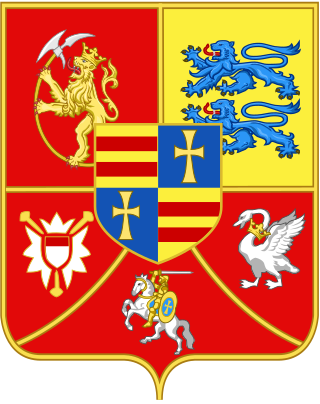
Holstein-Gottorp or Schleswig-Holstein-Gottorp is the historiographical name, as well as contemporary shorthand name, for the parts of the duchies of Schleswig and Holstein, also known as Ducal Holstein, that were ruled by the dukes of Schleswig-Holstein-Gottorp, a side branch of the elder Danish line of the House of Oldenburg. Other parts of the duchies were ruled by the kings of Denmark.

Bremen-Verden, formally the Duchies of Bremen and Verden, were two territories and immediate fiefs of the Holy Roman Empire, which emerged and gained imperial immediacy in 1180. By their original constitution they were prince-bishoprics of the Archdiocese of Bremen and Bishopric of Verden.

The Torstenson war, Hannibal controversy or Hannibal War was a short period of conflict between Sweden and Denmark–Norway from 1643 to 1645 towards the end of the Thirty Years' War. The names refer to Swedish general Lennart Torstenson and Norwegian governor-general Hannibal Sehested.
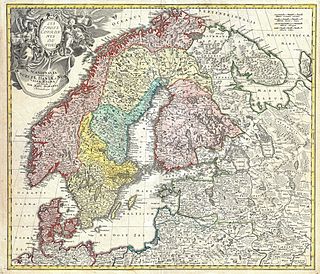
The history of Scandinavia is the history of the geographical region of Scandinavia and its peoples. The region is located in Northern Europe, and consists of Denmark, Norway and Sweden. Finland and Iceland are at times, especially in English-speaking contexts, considered part of Scandinavia.

The Scanian War was a part of the Northern Wars involving the union of Denmark–Norway, Brandenburg and Sweden. It was fought from 1675 to 1679 mainly on Scanian soil, in the former Danish and Norway provinces along the border with Sweden, and in Northern Germany. While the latter battles are regarded as a theater of the Scanian war in English, Danish, Norwegian and Swedish historiography, they are seen as a separate war in German historiography, called the Swedish-Brandenburgian War.

Christian I, Prince of Anhalt-Bernburg, also known as Christian of Anhalt, was a German prince of the House of Ascania. He was ruling prince of Anhalt and, from 1603, ruling prince of the revived principality of Anhalt-Bernburg. From 1595 he was governor of Upper Palatinate, and soon became the advisor-in-chief of Frederick IV, Elector Palatine.

The Treaty or Peace of Lübeck ended the Danish intervention in the Thirty Years' War. It was signed in Lübeck on 22 May 1629 by Albrecht von Wallenstein and Christian IV of Denmark, and on 7 June by Ferdinand II, Holy Roman Emperor. The Catholic League was formally included as a party. It restored to Denmark–Norway its pre-war territory at the cost of final disengagement from imperial affairs.

The siege of Stralsund was a siege laid on Stralsund by Albrecht von Wallenstein's Imperial Army during the Thirty Years' War, from 13 May 1628 to 4 August 1628. Stralsund was aided by Denmark and Sweden, with considerable Scottish participation. The lifting of the siege ended Wallenstein's series of victories, and contributed to his downfall. The Swedish garrison in Stralsund was the first on German soil in history. The battle marked the de facto entrance of Sweden into the war.
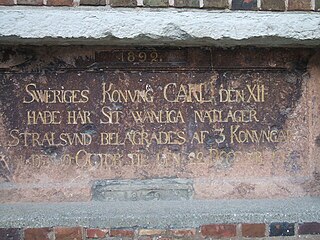
The siege of Stralsund was a battle during the Great Northern War. The Swedish Empire defended her Swedish Pomeranian port of Stralsund against a coalition of Denmark-Norway, the Electorate of Saxony and the Tsardom of Russia, which was joined by the Kingdom of Prussia during the siege.

The Peace of Travendal was a peace treaty concluded at the outset of the Great Northern War on 18 August 1700 between the Swedish Empire, Denmark–Norway and Holstein-Gottorp in Traventhal. Denmark had to return Holstein-Gottorp to its duke, a Swedish ally, and to leave the anti-Swedish alliance. The Danes only reentered the war after Sweden's major defeat in the Battle of Poltava, 1709, having used the time to reform their army. The treaty was guaranteed by France, the Holy Roman Empire, the United Provinces (Netherlands) and Great Britain.
The Battle of Wolgast was an engagement in the Thirty Years' War, fought on 22 August (O.S.) or 2 September (N.S.) 1628 near Wolgast, Duchy of Pomerania, Germany.

The capitulation of Franzburg was a treaty providing for the capitulation of the Duchy of Pomerania to the forces of the Holy Roman Empire during the Thirty Years' War. It was signed on 10 November (O.S.) or 20 November (N.S.) 1627 by Bogislaw XIV, Duke of Pomerania and Hans Georg von Arnim, commander in chief of an occupation force belonging to the army of Ferdinand II, Holy Roman Emperor, led by Albrecht von Wallenstein. While the terms of the capitulation were unfavourable for the Duchy of Pomerania already, occupation became even more burdensome when the occupation force did not adhere to the restrictions outlined in Franzburg. Stralsund resisted with Danish, Swedish and Scottish support, another Danish intervention failed. Imperial occupation lasted until Swedish forces invaded in 1630, and subsequently cleared all of the Duchy of Pomerania of imperial forces until 1631.
Events from the 1520s in Denmark.

The Battle of Kolding on January 9, 1644 was the opening engagement of the Torstenson War between the Swedish Empire and Denmark-Norway. The battle was primarily a cavalry engagement between Swedish and Danish cavalry near the Danish seaport of Kolding. The encounter was part of the wider Thirty Years' War, which saw heavy fighting in Central Europe. The Danish army made a defensive stand only to be overrun by the advancing Swedes. It was a decisive victory for the Swedish forces and by the end of January the Jutland peninsula was a Swedish possession.